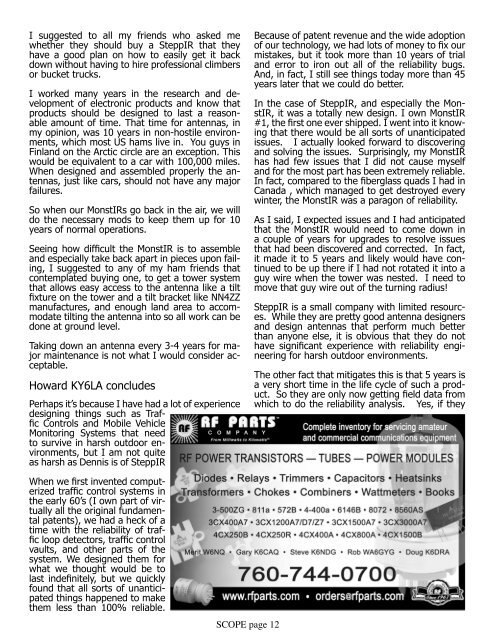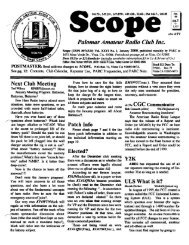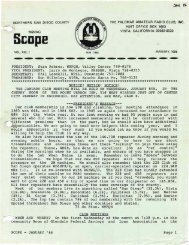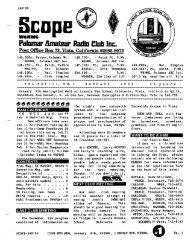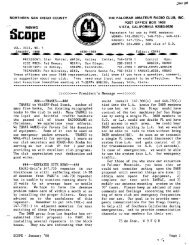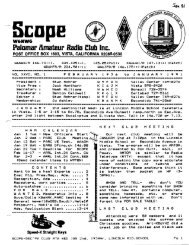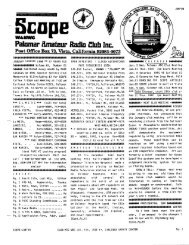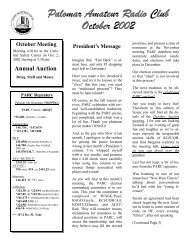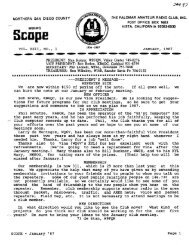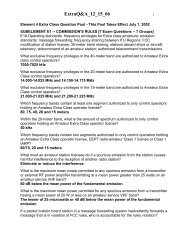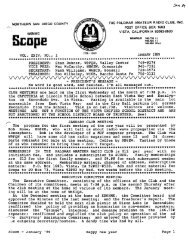Jan - Palomar Amateur Radio Club
Jan - Palomar Amateur Radio Club
Jan - Palomar Amateur Radio Club
Create successful ePaper yourself
Turn your PDF publications into a flip-book with our unique Google optimized e-Paper software.
I suggested to all my friends who asked me<br />
whether they should buy a SteppIR that they<br />
have a good plan on how to easily get it back<br />
down without having to hire professional climbers<br />
or bucket trucks.<br />
I worked many years in the research and development<br />
of electronic products and know that<br />
products should be designed to last a reasonable<br />
amount of time. That time for antennas, in<br />
my opinion, was 10 years in non-hostile environments,<br />
which most US hams live in. You guys in<br />
Finland on the Arctic circle are an exception. This<br />
would be equivalent to a car with 100,000 miles.<br />
When designed and assembled properly the antennas,<br />
just like cars, should not have any major<br />
failures.<br />
So when our MonstIRs go back in the air, we will<br />
do the necessary mods to keep them up for 10<br />
years of normal operations.<br />
Seeing how difficult the MonstIR is to assemble<br />
and especially take back apart in pieces upon failing,<br />
I suggested to any of my ham friends that<br />
contemplated buying one, to get a tower system<br />
that allows easy access to the antenna like a tilt<br />
fixture on the tower and a tilt bracket like NN4ZZ<br />
manufactures, and enough land area to accommodate<br />
tilting the antenna into so all work can be<br />
done at ground level.<br />
Taking down an antenna every 3-4 years for major<br />
maintenance is not what I would consider acceptable.<br />
Howard KY6LA concludes<br />
Perhaps it’s because I have had a lot of experience<br />
designing things such as Traffic<br />
Controls and Mobile Vehicle<br />
Monitoring Systems that need<br />
to survive in harsh outdoor environments,<br />
but I am not quite<br />
as harsh as Dennis is of SteppIR<br />
Because of patent revenue and the wide adoption<br />
of our technology, we had lots of money to fix our<br />
mistakes, but it took more than 10 years of trial<br />
and error to iron out all of the reliability bugs.<br />
And, in fact, I still see things today more than 45<br />
years later that we could do better.<br />
In the case of SteppIR, and especially the MonstIR,<br />
it was a totally new design. I own MonstIR<br />
#1, the first one ever shipped. I went into it knowing<br />
that there would be all sorts of unanticipated<br />
issues. I actually looked forward to discovering<br />
and solving the issues. Surprisingly, my MonstIR<br />
has had few issues that I did not cause myself<br />
and for the most part has been extremely reliable.<br />
In fact, compared to the fiberglass quads I had in<br />
Canada , which managed to get destroyed every<br />
winter, the MonstIR was a paragon of reliability.<br />
As I said, I expected issues and I had anticipated<br />
that the MonstIR would need to come down in<br />
a couple of years for upgrades to resolve issues<br />
that had been discovered and corrected. In fact,<br />
it made it to 5 years and likely would have continued<br />
to be up there if I had not rotated it into a<br />
guy wire when the tower was nested. I need to<br />
move that guy wire out of the turning radius!<br />
SteppIR is a small company with limited resources.<br />
While they are pretty good antenna designers<br />
and design antennas that perform much better<br />
than anyone else, it is obvious that they do not<br />
have significant experience with reliability engineering<br />
for harsh outdoor environments.<br />
The other fact that mitigates this is that 5 years is<br />
a very short time in the life cycle of such a product.<br />
So they are only now getting field data from<br />
which to do the reliability analysis. Yes, if they<br />
When we first invented computerized<br />
traffic control systems in<br />
the early 60’s (I own part of virtually<br />
all the original fundamental<br />
patents), we had a heck of a<br />
time with the reliability of traffic<br />
loop detectors, traffic control<br />
vaults, and other parts of the<br />
system. We designed them for<br />
what we thought would be to<br />
last indefinitely, but we quickly<br />
found that all sorts of unanticipated<br />
things happened to make<br />
them less than 100% reliable.<br />
SCOPE page 12


